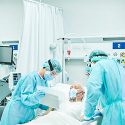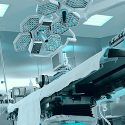Infectious Diseases Research
Infectious Diseases Research
Infectious diseases research at SSIM is currently focused on influenza and coronavirus strains, biomarkers for the rapid detection of Pseudomonas aeruginosa in eye Infections, and antibiotic-resistant pathogens, as described below.
If you are interested in any SSIM project as an investor, philanthropist, or potential partner, please email dellis@diref.org or complete the short form at the bottom of this page.

Influenza and Coronavirus
Influenza virus continues to be responsible for widespread respiratory disease, death, and significant economic loss despite global vaccination and eradication programs. This is of particular concern in light of recent outbreaks of avian influenza, particularly H5N1 in humans, H1N1, and the recent Ebola outbreak that have dramatically increased the awareness of vulnerabilities as a result of naturally occurring pandemic influenza with a particularly virulent strain or the introduction of a novel virus either naturally or intentionally.
A portable detection device providing an accurate and rapid diagnosis, within less than 30 minutes, would be an invaluable tool in combating influenza pandemics. The additional capability of strain-specific identification and reliable diagnosis technique for influenza virus in a wide range of applications would help to contain pandemic spreading of these viruses by providing invaluable input into vaccination and treatment strategies worldwide. An immediate diagnosis of influenza in patients with febrile illness will facilitate timely administration of antivirals and appropriate isolation and quarantine measures to protect the public, healthcare workers, and first responders.
Moreover, the ability to rapidly distinguish between bacterial and viral infections during a pandemic or normal day-to-day medical care, will decrease the inappropriate use of antibiotics and help to curtail the exponential increase in antimicrobial resistant pathogens. We are developing a complete set of biomarkers for our Rapid Influenza Detection System (RIDS) for use in a field setting, austere medical facility during a rapidly escalating mass casualty public health event.
Biomarkers for Rapid Detection of Pseudomonas Aeruginosa in Eye Infections
Staphylococcus aureus, Streptococcus pneumoniae and Pseudomonas aeruginosa are ocular pathogens that commonly cause bacterial conjunctivitis (pink eye) and bacterial keratitis. Bacterial conjunctivitis can typically be resolved without severe complication, however, bacterial keratitis (an acute or chronic, transient infection of the cornea) can lead to blindness due to corneal scaring. Pseudomonas aeruginosa is of particular concern since it contains an enzyme that can degrade the cornea and can cause corneal proliferation leading to enucleation within 2 to 3 days.
Raman Spectroscopy is a non-contact, non-destructive, optical technique that provides the unique spectral fingerprint of a molecule under investigation making it a promising platform for microbial keratitis detection.
Antibiotic-Resistant Pathogens
The rise in use of antibiotics has contributed to a serious threat to public health due to rising rates of antimicrobial resistance. The emergence of resistance in bacterial strains in a natural adaptive response to regular antibiotic use, though propagation of resistance has been aggravated by inappropriate use of antibiotics.
Resistance in many bacterial strains has become a growing concern and has contributed to economic tolls due to the expensive costs in healthcare and associated loss of productivity. Effective treatment against resistant infections relies upon accurately identifying the resistance that a pathogen has developed. The most common tool for identifying resistance to antibiotic treatment is cultivating colonies in antibiotic containing plates. Such a process may take days before results are appropriate for identification. Such long waiting periods pose a problem for serious infections where immediate action is needed.
We are investigating the viability of Raman spectroscopy based assay in detecting β-lactam antibiotic resistance in staphylococcus aureus cultures after a short period of exposure. Spectra comparisons are conducted using statistical methods designed to find consistent markers which will be implemented into a database. Additionally, spectra from samples subjected to varying exposure time will be compared for patterns and to determine to quickest time possible to detect notable differences. This will also be adapted to other forms of resistant pathogens.
Contact Us
Smart Sensors and Integrated Microsystems (SSIM) Program
Wayne State University
College of Engineering Room 3172
5050 Anthony Wayne Drive
Detroit, MI 48202
Ph: 313-577-1306
Fax: 313-577-1101








